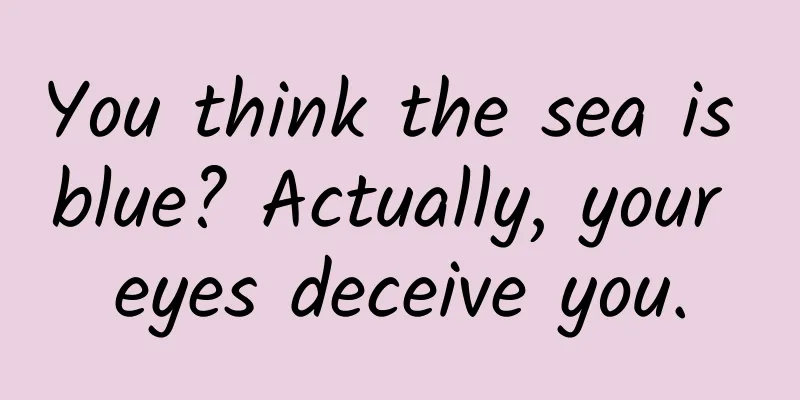You think the sea is blue? Actually, your eyes deceive you.

|
Is the ocean really blue? In a study published in the journal Nature, scientists from MIT and the UK National Oceanography Centre report that the color of the ocean has changed significantly over the past 20 years . These color changes, while subtle and imperceptible to the human eye, have occurred across 56% of the world's oceans - an area larger than the total land area on Earth. In particular, the researchers found that tropical ocean regions near the equator have become increasingly greener over time. Changes in ocean color suggest that ecosystems at the ocean surface are also changing , as the color of the ocean is a true reflection of the organisms and materials in its waters. At this point, the researchers can't say exactly how the ocean ecosystems have altered to reflect the change in color. But they are pretty sure of one thing: human-induced climate change is likely to be to blame . "Simulations I've been running for years told me these changes in ocean color were going to happen," says study co-author Stephanie Dutkiewicz, a senior research scientist in MIT's Department of Earth, Atmospheric and Planetary Sciences and the Center for Global Change Science. "To see it actually happen is not surprising, but it is scary. These changes are consistent with human-caused climate change." "This provides additional evidence for how human activities are affecting life on Earth over vast spatial scales," added lead author Dr BB Cael of the National Oceanography Centre in Southampton, UK. "It is yet another way that humans are influencing the biosphere." The color of the ocean is a visual product of what's in the upper layers of the ocean. Generally, dark blue waters reflect little life, while greener waters indicate the presence of ecosystems, primarily phytoplankton - plant-like microorganisms containing chlorophyll that are abundant in the upper layers of the ocean. Phytoplankton are the foundation of the ocean food web, supporting an increasingly complex array of organisms, including krill, fish, seabirds and marine mammals. In the ocean, phytoplankton are also a powerful force in capturing and storing carbon dioxide. Scientists are therefore keen to monitor phytoplankton in the surface ocean and observe how these important communities respond to climate change. To do this, they track changes in chlorophyll based on the ratio of blue to green light reflected from the ocean surface. But about 10 years ago, Stephanie Henso and others at the National Oceanography Center in the United States published a paper stating that if only chlorophyll is tracked, at least 30 years of continuous monitoring will be needed to detect any trends driven specifically by climate change. The research team believes that the reason is that the huge natural variation in chlorophyll from year to year will overwhelm any human influence on chlorophyll concentrations. In 2019, Dutkiewicz and colleagues published another paper showing, using a new model, that natural variations in other ocean colors are much smaller than in chlorophyll. Therefore, any climate change-driven changes should be easier to detect than the smaller normal variations in other ocean colors. They predicted that these changes would show up in 20 years of monitoring rather than 30 years. “So I thought, wouldn’t it make sense to look for trends in all these other colors, rather than just in chlorophyll?” Cael said. “It’s worth looking at the whole spectrum, rather than just trying to estimate a number from a small part of the spectrum.” For the current study, Cael and his team analyzed measurements of ocean color from the Moderate Resolution Imaging Spectroradiometer (MODIS) on the Aqua satellite, which has been monitoring ocean color for 21 years. MODIS measures seven visible wavelengths, including the two colors that researchers have traditionally used to estimate chlorophyll. The differences in color captured by satellites are too subtle for the human eye to distinguish. To our eyes, the ocean appears mostly blue, but the true color may contain a mix of more subtle wavelengths from blue to green and even red. Cael conducted a statistical analysis using all seven ocean colors measured by satellites between 2002 and 2022. He first looked at how the seven colors changed over different regions throughout the year to get an idea of their natural variability. He then zoomed out to see how the annual variation in ocean color changed over a 20-year period. This analysis showed a clear trend - higher than normal year-to-year variation. To see if the trend was linked to climate change, Cael then looked at a model that Dutkiewicz had built in 2019. The model simulated Earth's oceans under two scenarios: one with increasing greenhouse gases and one without them. The greenhouse gas model predicted a significant trend within 20 years that would cause about 50% of the world's ocean surface to change color — almost exactly what Cael found when analyzing real-world satellite data. Modeled Rrs ToEs for 20 years or less are similar in location and range to those for the observed 20-year data "This suggests that the trends we observe are not random variations in the Earth system," Cael said. "This is consistent with anthropogenic climate change." "The color of the ocean has changed," Dutkiewicz said. "The color change reflects changes in the plankton community, which will affect all the organisms that feed on plankton. This will also change the amount of carbon the ocean absorbs, because different types of plankton have different uptake capacities. So, we want people to take this seriously, not just because the models predict these changes will happen, but because we can now see that the ocean is changing." References: https://www.nature.com/articles/s41586-023-06321-z |
<<: The Forbidden City: Let’s talk about those little-known little-known facts about the palace~
>>: The development of resources across the entire solar system requires these new technologies!
Recommend
What is the operation direction and value of mobile game products?
Even without an operations team, the company can ...
Solving the three major problems of Mount Everest: What black technologies did DJI drones use to set the highest transportation record?
Tuchong Creative Mount Everest was once a forbidd...
Tencent smart car iSPACE real shot at Guangzhou Auto Show: looks like an enhanced version of Chery QQ?
Not only Tesla owned by "Iron Man" Musk...
How to effectively improve the conversion effect of information flow?
The cost remained at 180 a few days ago, why did ...
Do these 5 things well and the click-through rate of information flow advertising materials will increase by 90%
What does craftsmanship require? Humility, persev...
You never expected that the "good habits" you have been sticking to may drag down your body
Reviewer of this article: Chen Haixu, Deputy Dire...
How did the Eight Immortals cross the sea? What magical powers did they display?
Everyone has heard of the mythical story "Ei...
The "ceiling" of human timekeeping, with an error of only 1 second in billions of years! Revealing the most accurate clock in space
Last October, with the successful launch of the M...
What are short video information flow ads? What is the difference with DOU+?
Unknowingly, feed stream (also known as informati...
How to operate a good community?
Introduction: Although all operations have common...
Faraday Future has not yet finalized its financing and notified employees to continue to be on unpaid leave
According to foreign media reports, an internal e...
Is it expensive to join the Chenzhou Paper Products Mini Program? Chenzhou Paper Products Mini Program Franchise Fees List
What is the price to join the Chenzhou Paper Prod...
A small step towards lunar colonization: Scientists grow plants in lunar soil for the first time
In 1969, American astronaut Neil Armstrong succes...
Community Operation丨The essence and gameplay of "private domain traffic" in 2019!
Last year, every time I attended a marketing indu...
[Smart Farmers] How to check if fruits are "injured"? Fruit "Doctor" is now online!
In modern agriculture and food production, ensuri...









